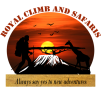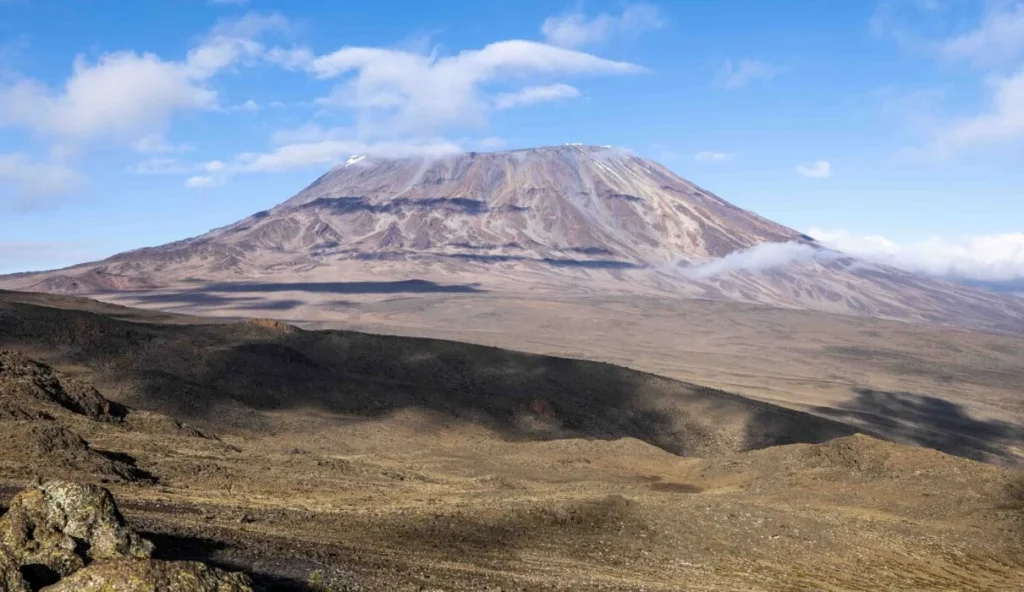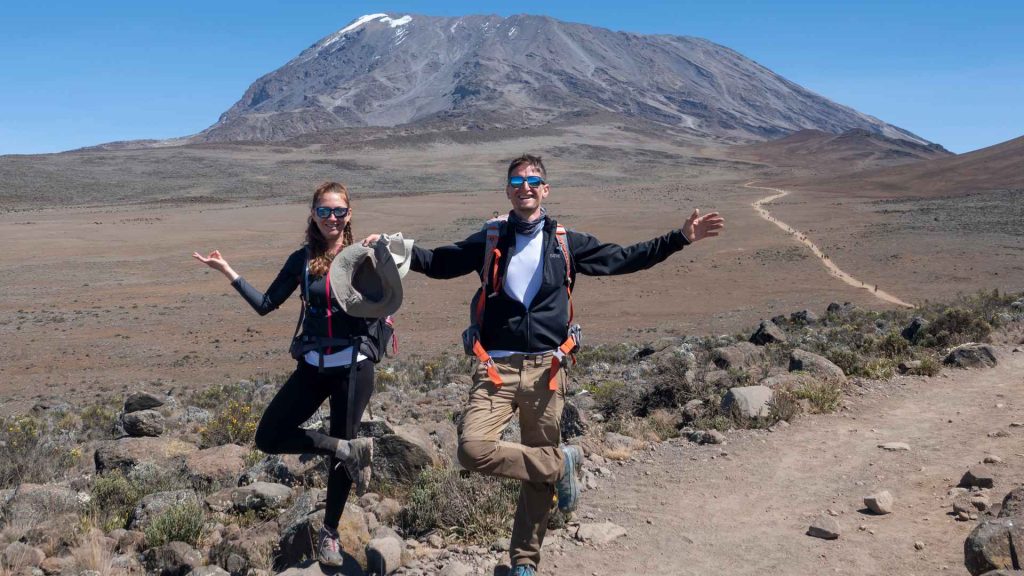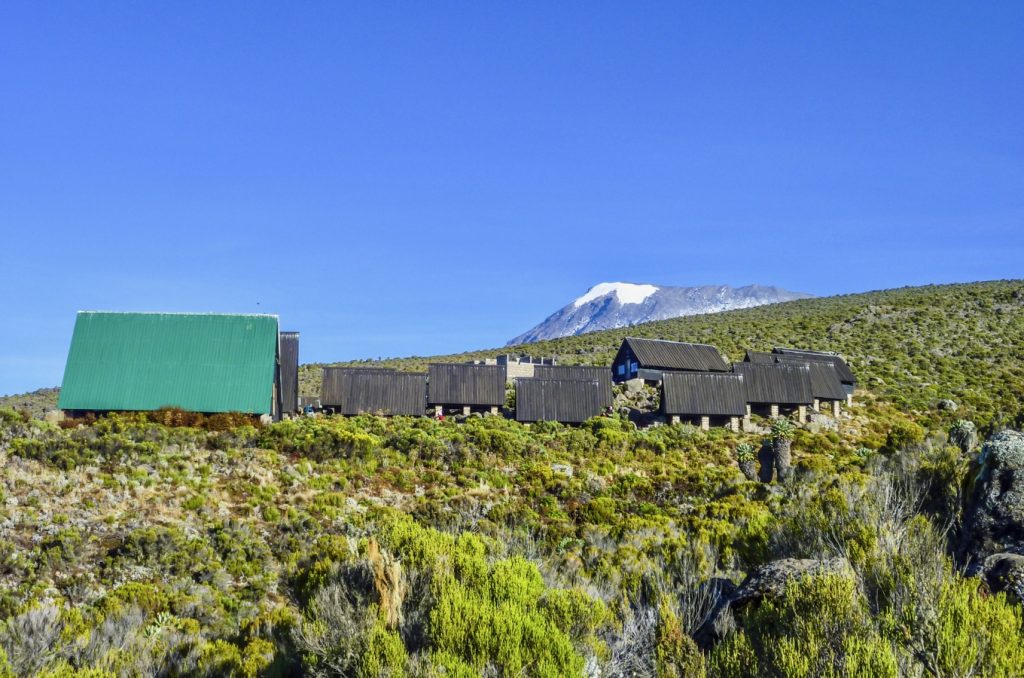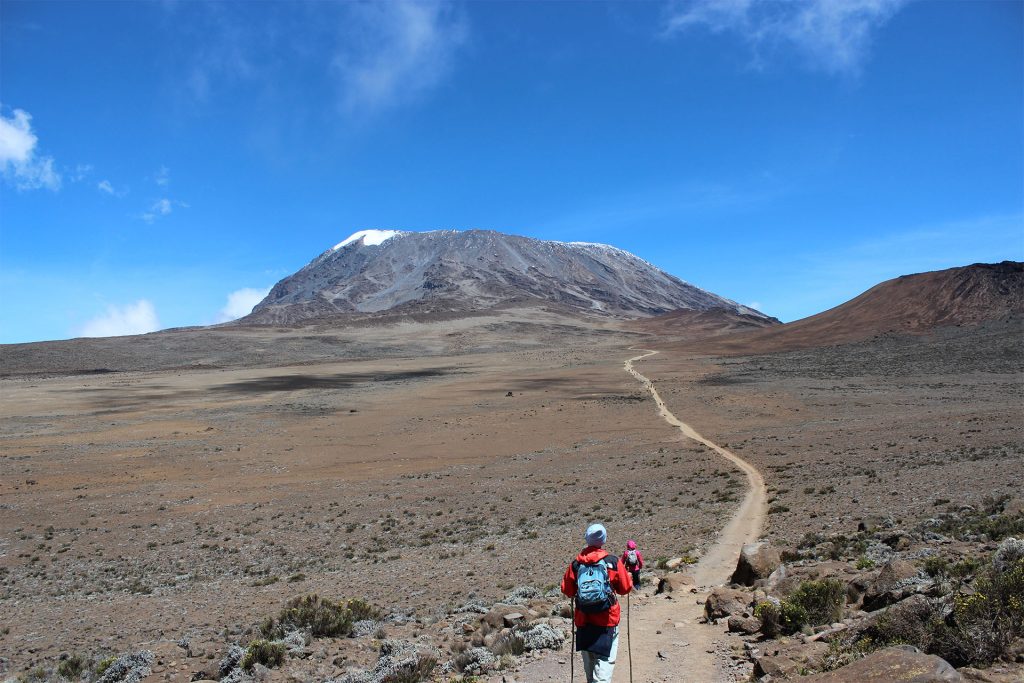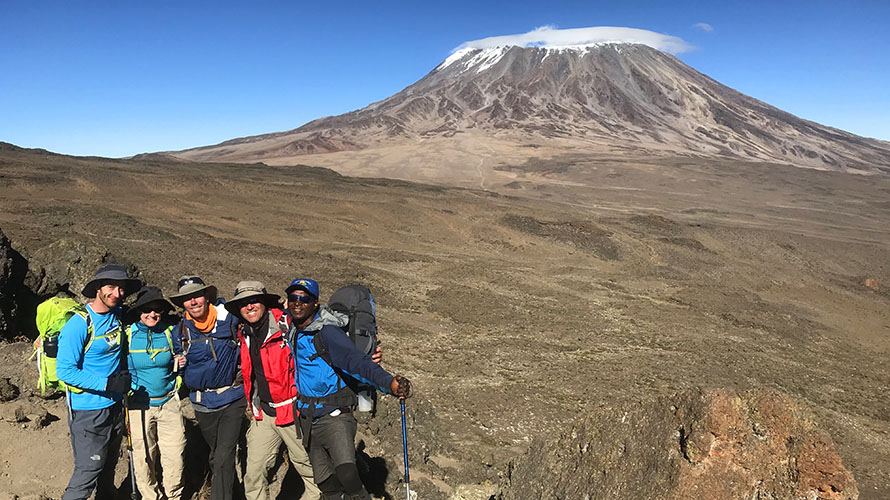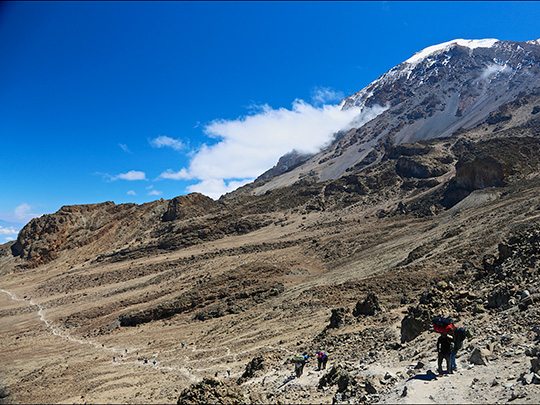MOUNT KILIMANJARO MARANGU ROUTE
The Marangu route which is also known as the Coca-Cola route is the least expensive route to the summit. This is also the only route with the comforts of sleeping huts at every campsite with solar lights and comfortable beds.
The huts are communal, and the bunks have a sponge mattress and pillow.
There are 60 beds at both Mandara and Kibo Huts and 120 beds at Horombo Hut. Bathrooms and running water are available at the two lower huts. Mens’ and ladies’ latrines are available at the last camp but are very basic.
All climbing groups, often from several countries around the world, share meals in dining huts providing a jovial and energetic atmosphere.
This route is usually done in 5 days (the shortest route to the summit) but can be done in 6 days for better acclimatization. The extra day can be spent resting at Horombo or climbing the small peak of Mawenzi.
Climbing Mount Kilimanjaro via The Marangu Route
Marangu Route, commonly known as the Coca Cola route is more popular because it can be done in fewer days and has permanent sleep huts at the campsites.
Summit night from Kibo Hut is steep and passes Gilman’s Point to Uhuru Peak. It is a shorter route with a steeper incline and less time for acclimatization it tends to have a lower summit success rate. This is the only route where the ascent and descent route is shared, thus creating more traffic.
Duration: 5 or 6 days
Difficulty: Medium
Scenery: Good
Traffic: High
Itinerary
Day 0: Arrival in Tanzania at Kilimanjaro International Airport.(JRO)
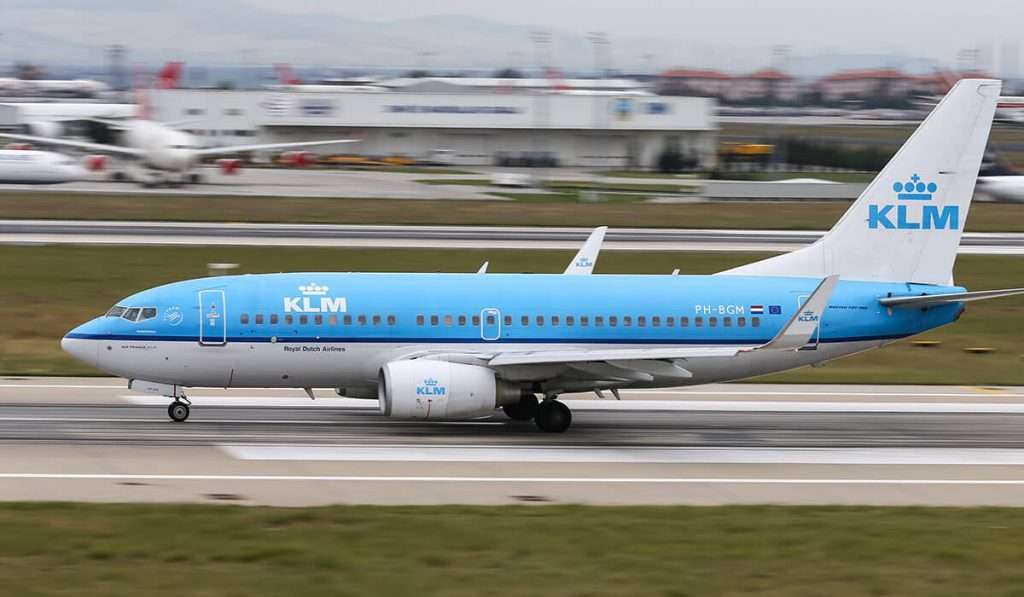
We will pick you up from Kilimanjaro Airport or Arusha Airport and transfer you to your hotel in Moshi. A pre-trek briefing will be held at your Moshi hotel. You should plan to arrive at least one day before the start of the trek. Today, we will focus on having a pre-trek briefing, during which we will review your equipment and rent any gear that is needed.
DAY 1: MARANGU GATE – MANDARA HUTS: 8.3km /5mi | 4-5 hrs | Rainforest
Elevation: 1905m/6250ft to 2723m/8934ft
Altitude gained: 818m
Departing from Moshi a 1-hour drive will take you through the Village of Marangu to the Kilimanjaro National Park Gate. We will patiently wait for our permits to be issued while watching the hustle and bustle of operations as many crews prepare for the journey ahead Enjoy the beautiful rainforest scenery and windy trails while your guide tells you about the local flora and fauna and natural wildlife. At these lower elevations, the trail can be muddy and quite slippery. We highly recommend gaiters and trekking poles here.
DAY 2: MANDARA HUTS – HOROMBO HUTS: 12.5km/7.8mi | 6-8hrs | Mooreland
Elevation: 2723m/8934ft to 3721m/12,208ft
Altitude gained: 998m
After a good night’s sleep and a hearty breakfast, we emerge from the rain forest and continue on an ascending path, through the heathland, looking for giant lobelias and groundsels. Continue up into open moorlands where small shrubs are the main vegetation. Stop halfway for lunch, to enjoy amazing views of Mawenzi. Arrive at the Horombo Huts late afternoon beneath the spectacular Kibo Summit viewpoint. Temperatures begin to drop.
DAY 3: HOROMBO HUTS
You can spend a full day and a second night at Horombo. On this day, you can either rest at the huts or take a stroll up to the Mawenzi base camp then return to the Horombo Huts. This extra day will help your acclimatization, and further your understanding of the mountain’s weather and altitude. After your pause, you will continue up to the Kibo Huts on your fourth day for your midnight start to the summit.
DAY 4: HOROMBO HUTS- KIBO HUTS: 10.5km/6mi | 6-8hrs | Semi-Desert
Elevation: 3721m/12,208ft to 4714m/15,466ft
Altitude gained: 993m
After breakfast, we continue on through the dwindling heathland that blends into a moonscape as you enter the sweeping saddle connecting Mawenzi and Kibo. Here while we stop for lunch, and later when you cross this surprisingly large saddle, you can examine the summit climb up Kibo that you will be starting in just a few hours.
DAY 5: KIBO HUTS – SUMMIT: 6.25km /3.9 mi up | 5-7hrs | – HOROMBO HUTS: 15.75km /9mi down | 5-6hrs | Glaciers, Snow Capped Summit
Elevation: 4714m/15,466ft to 5895m/19,341ft
Altitude gained: 1181m
Descent to 3721m/12,208ft
Altitude lost: 2174m
Excitement is building as morning comes with an early start between midnight and 2 a.m. This is the most mentally and physically challenging portion of the trek.
We continue our way to the summit in a switchback formation trying to stay warm and focused on the amazing sense of accomplishment that lies ahead. With a switchback motion, we ascend through heavy scree and possibly snow toward Gillman’s Point on the crater rim. You will be rewarded with the most magnificent sunrise during your short rest here. Faster hikers may view the sunrise from the summit. From here on your remaining 1 hour ascent to Uhuru Peak, you are likely to encounter snow all the way.
Congratulations, one step at a time you have now reached Uhuru Peak the highest point on Mount Kilimanjaro and the entire continent of Africa!
After photos, celebrations and maybe a few tears of joy we take a few moments to enjoy this incredible accomplishment. We begin our steep descent down to Mweka Camp, stopping at Barafu for lunch and a very brief rest. We strongly recommend gaiters and trekking poles for uncooperative loose gravel and volcano ash terrain. Well-deserved rest awaits you to enjoy your last evening on the mountain. Overnight Mweka Camp.
DAY 6: HOROMBO HUTS – MARANGU GATE – MOSHI: 20km/12.5mi |6-7hrs | Rainforest
Elevation: 3721m/12,208 to 1905m/6250ft
Altitude lost: 1816m
After breakfast and a heartfelt ceremony of appreciation and team bonding with your crew, it’s time to say goodbye. We continue the descent down stopping at the Mandara Huts for lunch. Remember to tip your guides, cooks, and porters, since you will be leaving them here. You return back to the Marangu Park Gate and receive your summit certificates. As the weather is drastically warmer, the terrain is wet, muddy, and steep and we highly recommend Gaiters and trekking poles. From the gate, a vehicle will meet you to drive you back to your hotel in Moshi (about 45 minutes). Enjoy a long overdue hot shower, dinner, and celebrations!!
DAY 0: TRANSFER FROM THE HOTEL TO KILIMANJARO AIRPORT OR ARUSHA AIRPORT
Your driver will pick you up from your hotel at the scheduled time for your departure. After a relaxing stay and completing your Kilimanjaro adventure with Royal Climb and Safaris, you’ll enjoy a comfortable transfer to Kilimanjaro International Airport (JRO). The drive offers you a final view of Tanzania’s beautiful landscapes as you head to the airport to catch your flight.
Please make sure to have all your luggage and travel documents ready for the journey. Safe travels and we hope to welcome you back soon!

INCLUDED IN THE TREKKING PACKAGE:
- 2 Nights Hotel in Moshi: Bed & Breakfast before starting a tour and after the tour
- Private transport to/from Kilimanjaro International Airport to your hotel in Moshi
- Qualified guides with mountain crew
- National Park fees
- 18% VAT on tour fees and services
- All camping accommodations
- Mountain tents
- Transport
- Rescue fees
- All needs on the mountain (breakfast, lunch and dinner)
- Guides and porters’ accommodations and their entry fees on the mountain
- Pulse oximeter
- First aid kit
- Emergence oxygen
- Sleeping mats
- Treated water through the trek
- Fair wages to guides and porters as approved by Kilimanjaro National Park Authority
EXCLUDED FROM TREKKING PACKAGE:
- Flights
- Visa
- Tips to mountain crew
- Private toilet ($120 per group)
- Laundry services.
Private Trek
Please find below the prices for organizing a private trek. The prices are based on your group size.
Solo Trekker – USD 1850 per person
Group of 2 – 4 USD 1750 per person
Group of 5 – 9 USD 1650 per person
Group of 10+ USD 1560 per person
Prices quoted are subject to current Government Regulated Park Fees at the time of departure
Payment Terms
Deposit Payment
The deposit is 20% of the total booking amount.
Deposit can be paid either via a bank transfer or an online card payment.
We offer bank accounts in USD currencies for bank transfers.
Once you make the advance payment you will receive a booking confirmation.
Balance Payment
Balance can be paid via bank transfer or with cash.
Bank payment can be made 15 days before the tour date (recommended 30 days prior).
Cash can be paid on arrival (USD printed in or after the year 2009).
Cancellation Policy
8 days and above departure
No cancellation fees.
0 to 7 days before departure
50% of the total tour price will be charged as cancellation fees.
Trek can be postponed to any new date without any extra cost at any point in time.
The 5% surcharge paid for either or both advance and balance payments is non-refundable in case of cancellation of the trek.
Frequently Asked Questions (FAQ) – Mount Kilimanjaro Trek & Arrival in Tanzania
Whether you’re planning your first Kilimanjaro trek or are a seasoned adventurer, it’s common to have questions about the journey and logistics. Here’s a comprehensive list of FAQs to help you prepare for your Mount Kilimanjaro trek and arrival in Tanzania.
General Questions about Kilimanjaro Trekking
1. What is the best time to climb Mount Kilimanjaro?
- The best months for trekking Kilimanjaro are during the dry seasons, from June to October and December to February. These months offer the best weather conditions for a successful and enjoyable trek.
2. How fit do I need to be to climb Kilimanjaro?
- Kilimanjaro is non-technical but physically demanding. You should be in good physical condition with a focus on cardio fitness, strength training, and endurance. Prepare by hiking and increasing your stamina before the trek.
3. Which route is the best for climbing Kilimanjaro?
- Lemosho Route is highly recommended for its scenic beauty, lower crowd levels, and excellent acclimatization profile, making it ideal for first-time climbers. Other popular routes include the Machame and Rongai routes.
4. What is the success rate of reaching the summit?
- The summit success rate on longer routes like the 8-day Lemosho Route is around 90%, as it allows for better acclimatization compared to shorter routes.
5. What is the altitude of Uhuru Peak?
- Uhuru Peak, the summit of Mount Kilimanjaro, stands at 5,895 meters (19,341 feet) above sea level.
6. How many days does it take to climb Kilimanjaro?
- Most itineraries range from 6 to 8 days. The 8-day Lemosho Route is highly recommended as it provides the best balance of time for acclimatization and success.
7. Do I need a guide to climb Kilimanjaro?
- Yes, it is mandatory to have a licensed guide. Royal Climb and Safaris provides professional, experienced guides for all Kilimanjaro treks.
8. How cold does it get on Kilimanjaro?
- Temperatures vary depending on the altitude. At the summit, night temperatures can drop to -20°C (-4°F), so you’ll need appropriate cold-weather gear.
9. Will I experience altitude sickness?
- Altitude sickness is a possibility on Kilimanjaro. Symptoms can include headaches, nausea, and shortness of breath. Our guides monitor your condition daily to ensure safe acclimatization. Drinking plenty of water and trekking slowly (“pole pole”) can help prevent symptoms.
10. What do I eat during the trek?
- You’ll be provided with nutritious meals throughout the trek, including soups, pasta, rice, vegetables, and protein. Special dietary requirements can be accommodated with advance notice.
Packing and Gear Questions
11. What equipment do I need for the Kilimanjaro trek?
- Essential items include a good-quality sleeping bag, trekking boots, warm clothing, rain gear, and a headlamp. A complete gear list will be provided when booking with Royal Climb and Safaris, and gear rental is available.
12. Can I rent equipment for Kilimanjaro?
- Yes, equipment like sleeping bags, trekking poles, and down jackets can be rented upon arrival.
13. How much weight do the porters carry?
- Porters carry up to 15 kg of your gear. You will carry a daypack with essentials like water, snacks, and extra clothing layers.
Arrival in Tanzania and Logistics
14. Do I need a visa to enter Tanzania?
- Most travelers require a visa to enter Tanzania. Visas can be obtained on arrival at Kilimanjaro International Airport (JRO) or online via the Tanzania eVisa system.
15. Which airport should I fly into?
- Kilimanjaro International Airport (JRO) is the nearest airport to Mount Kilimanjaro. It’s located between Arusha and Moshi, both of which are starting points for your trek.
16. What vaccinations are required for Tanzania?
- It’s recommended to have vaccinations for yellow fever, hepatitis A and B, typhoid, and tetanus. Check with your local travel clinic for any other requirements, especially if you’re arriving from a yellow fever-endemic country.
17. Do I need travel insurance for the trek?
- Yes, it is highly recommended to have comprehensive travel insurance that covers high-altitude trekking, emergency medical evacuation, and trip cancellations.
18. How do I get from the airport to the hotel?
- Royal Climb and Safaris provides airport transfers to and from Kilimanjaro International Airport. Our driver will meet you at the airport and transport you to your hotel for rest before your trek.
19. Where should I stay before and after the trek?
- Most trekkers stay in Moshi or Arusha before and after the trek. Royal Climb and Safaris can recommend comfortable hotels with all the amenities to help you relax before and after your climb.
Booking and Payment Questions
20. How far in advance should I book my Kilimanjaro trek?
- It’s best to book at least 3 to 6 months in advance to ensure availability and time for proper preparation.
21. What payment methods are accepted?
- Royal Climb and Safaris accept bank transfers, major credit cards, and cash payments (USD, or Tanzanian Shillings).
22. Are tips expected?
- Yes, tipping is customary after a successful trek. You can tip your guides, porters, and cooks at the end of the climb. We recommend a total tip of around $200-$300 per climber, which is shared among the team.
Miscellaneous Questions
23. Is Wi-Fi available in Kilimanjaro?
- There is no reliable Wi-Fi on the mountain, though mobile network coverage is available at certain points, especially lower down. It’s best to focus on disconnecting and enjoying the trek!
24. Can I charge my devices during the trek?
- There are no charging facilities on the mountain, so bringing a portable power bank is essential for keeping your camera and phone charged.
25. What happens if I can’t continue the trek?
- In the event that you experience altitude sickness or another issue, our team is prepared to safely escort you back down the mountain. Rescue fees are covered by your trekking permit.
26. What documents do I need for the trek?
- Make sure to bring a valid passport, visa (if applicable), proof of travel insurance, and any necessary vaccination certificates.
For any further questions, don’t hesitate to contact Royal Climb and Safaris. We’re here to make your Kilimanjaro adventure smooth, safe, and unforgettable!
Customer Reviews of Royal Climb and Safaris on TripAdvisor and Google Reviews
At Royal Climb and Safaris, we pride ourselves on delivering exceptional experiences to our clients, whether it’s trekking Mount Kilimanjaro, exploring Tanzania’s national parks, or enjoying cultural tours. Here’s what some of our happy adventurers have to say on TripAdvisor and Google Reviews:

